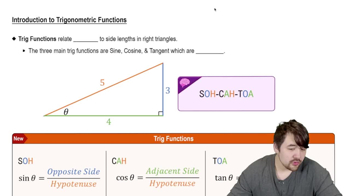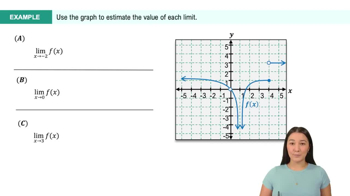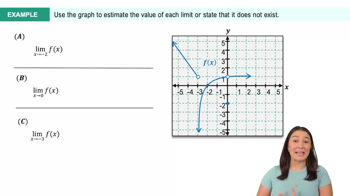Table of contents
- 0. Functions7h 52m
- Introduction to Functions16m
- Piecewise Functions10m
- Properties of Functions9m
- Common Functions1h 8m
- Transformations5m
- Combining Functions27m
- Exponent rules32m
- Exponential Functions28m
- Logarithmic Functions24m
- Properties of Logarithms34m
- Exponential & Logarithmic Equations35m
- Introduction to Trigonometric Functions38m
- Graphs of Trigonometric Functions44m
- Trigonometric Identities47m
- Inverse Trigonometric Functions48m
- 1. Limits and Continuity2h 2m
- 2. Intro to Derivatives1h 33m
- 3. Techniques of Differentiation3h 18m
- 4. Applications of Derivatives2h 38m
- 5. Graphical Applications of Derivatives6h 2m
- 6. Derivatives of Inverse, Exponential, & Logarithmic Functions2h 37m
- 7. Antiderivatives & Indefinite Integrals1h 26m
- 8. Definite Integrals4h 44m
- 9. Graphical Applications of Integrals2h 27m
- 10. Physics Applications of Integrals 2h 22m
1. Limits and Continuity
Introduction to Limits
Problem 2.2.55a
Textbook Question
a. Use a graphing utility to estimate lim x→0 tan 2x / sin x, lim x→0 tan 3x / sin x, and lim x→0 tan 4x / sin x.
 Verified step by step guidance
Verified step by step guidance1
To estimate the limits using a graphing utility, first understand the expressions: lim x→0 tan(2x) / sin(x), lim x→0 tan(3x) / sin(x), and lim x→0 tan(4x) / sin(x). These involve trigonometric functions where x approaches 0.
Graph each function separately: y = tan(2x) / sin(x), y = tan(3x) / sin(x), and y = tan(4x) / sin(x). Use a graphing calculator or software to plot these functions over an interval around x = 0, such as [-0.1, 0.1].
Observe the behavior of each graph as x approaches 0. The limit is the value that the function approaches as x gets closer to 0. Look for a horizontal line or a point where the function stabilizes near x = 0.
For each function, note the y-value that the graph approaches as x approaches 0. This y-value is the estimated limit for each expression.
Compare the estimated limits for each function. Notice any patterns or differences in the limits as the coefficient of x in the tangent function changes from 2 to 3 to 4.
 Verified video answer for a similar problem:
Verified video answer for a similar problem:This video solution was recommended by our tutors as helpful for the problem above
Video duration:
3mPlay a video:
Was this helpful?
Key Concepts
Here are the essential concepts you must grasp in order to answer the question correctly.
Limits
A limit is a fundamental concept in calculus that describes the behavior of a function as its input approaches a certain value. In this case, we are interested in the limits of the functions tan(kx) and sin(x) as x approaches 0. Understanding limits is crucial for evaluating expressions that may be indeterminate at specific points.
Recommended video:

One-Sided Limits
Trigonometric Functions
Trigonometric functions, such as sine and tangent, are periodic functions that relate angles to ratios of sides in right triangles. The behavior of these functions near specific points, like x = 0, is essential for evaluating limits. For small angles, both tan(x) and sin(x) can be approximated, which simplifies the limit calculations.
Recommended video:

Introduction to Trigonometric Functions
L'Hôpital's Rule
L'Hôpital's Rule is a method used to evaluate limits of indeterminate forms, such as 0/0 or ∞/∞. It states that if the limit of f(x)/g(x) results in an indeterminate form, the limit can be found by taking the derivative of the numerator and the derivative of the denominator. This rule can be particularly useful when dealing with limits involving trigonometric functions.
Recommended video:
Guided course

Power Rules

 6:47m
6:47mWatch next
Master Finding Limits Numerically and Graphically with a bite sized video explanation from Callie
Start learning




